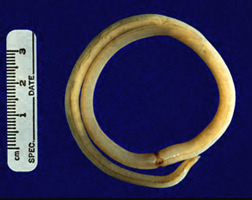What is Ascaris Lumbricoides?
5,109 viewsAscaris lumbricoides is the largest nematode (roundworm) parasitizing the human intestine. (Adult females: 20 to 35 cm; adult male: 15 to 30 cm.)

Adult worms live in the lumen of the small intestine. A female may produce approximately 200,000 eggs per day, which are passed with the feces . Unfertilized eggs may be ingested but are not infective. Fertile eggs embryonate and become infective after 18 days to several weeks, depending on the environmental conditions (optimum: moist, warm, shaded soil). After infective eggs are swallowed, the larvae hatch, invade the intestinal mucosa, and are carried via the portal, then systemic circulation to the lungs. The larvae mature further in the lungs (10 to 14 days), penetrate the alveolar walls, ascend the bronchial tree to the throat, and are swallowed. Upon reaching the small intestine, they develop into adult worms. Between 2 and 3 months are required from ingestion of the infective eggs to oviposition by the adult female. Adult worms can live 1 to 2 years.
And according to wikipedia:
Ascaris lumbricoides is the member of the Ascaris family responsible for the disease Ascariasis.
It can reach a length of up to 35 cm.
Ascaris lumbricoides, or “roundworm”, infections in humans occurs when an ingested infective egg releases a larval worm that penetrates the wall of the duodenum and enters the bloodstream. From here, it is carried to the liver and heart, and enters pulmonary circulation to break free in the alveoli, where it grows and molts. In 3 weeks, the larvae pass from the respiratory system to be coughed up, swallowed, and thus returned to the small intestine, where they mature to adult male and female worms. Fertilization can now occur and the female produces as many as 200,000 eggs per day for a year. These fertilized eggs become infectious after 2 weeks in soil; they can persist in soil for 3 years or more.
Infections with these parasites are more common where sanitation is poor and human feces are used as fertilizer.
Prevention of this infection centers around education, not using human feces as fertilizer, and cleanliness, especially among those who handle food.
More than 1 billion people are affected by this infection.
See the wikipedia article here.
Please, take care with her, or your abdomen can… (see here).
